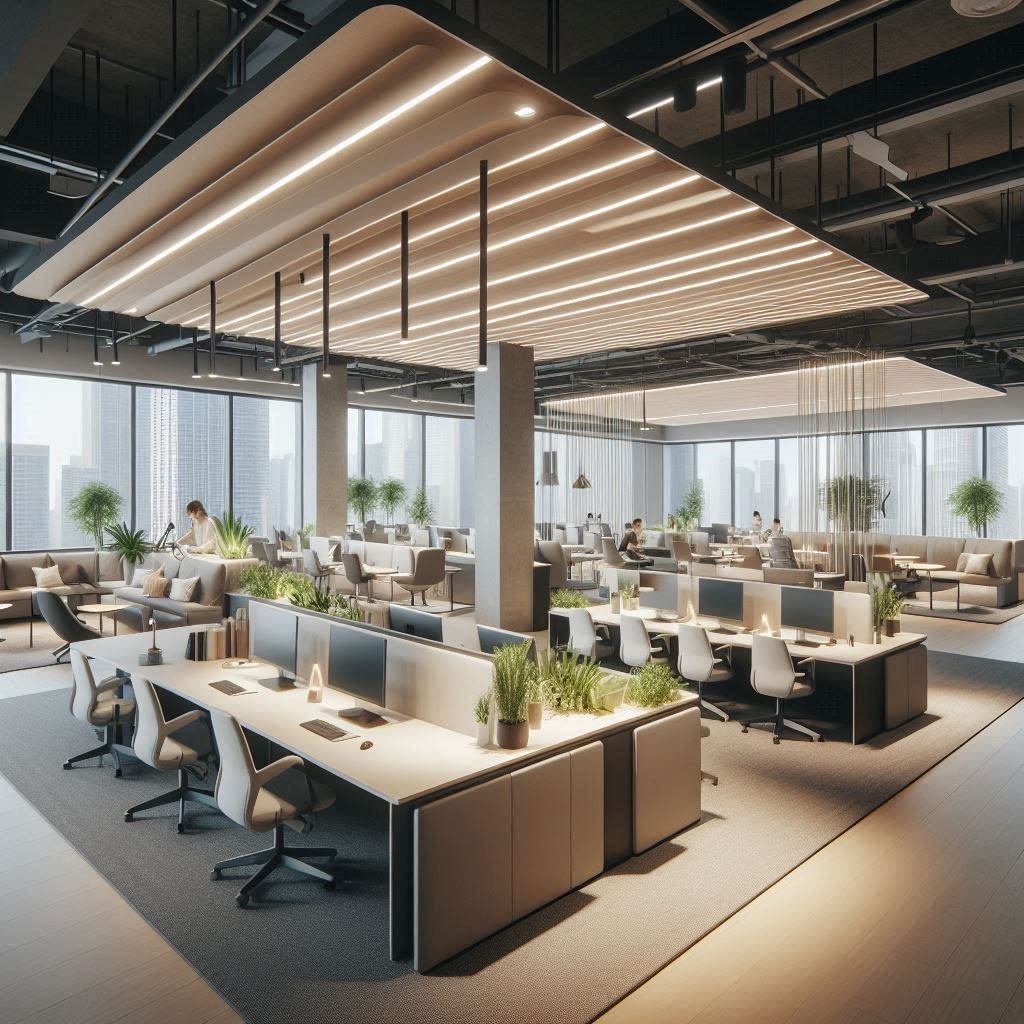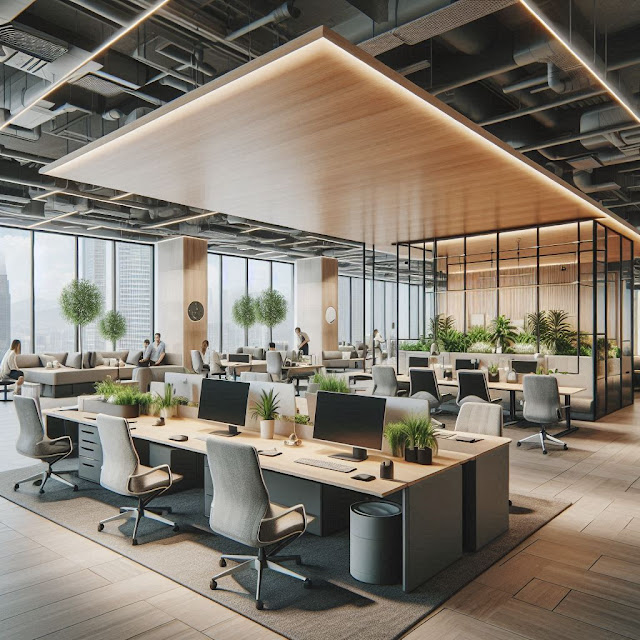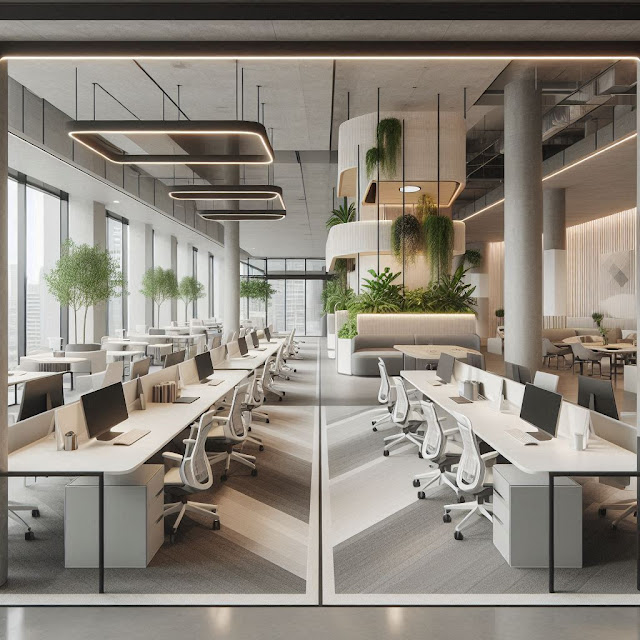The shift to hybrid work models, blending remote and in-office work, has transformed how businesses approach office design. Modern office interiors for hybrid workspaces prioritize flexibility, collaboration, and employee well-being while integrating advanced technology and sustainable practices. This article explores the key elements, trends, and considerations for designing office interiors that cater to the dynamic needs of hybrid work environments, ensuring productivity, engagement, and adaptability.
Understanding Hybrid Workspaces
Hybrid workspaces accommodate employees who split their time between working from home, client sites, or the office. Unlike traditional offices designed for daily attendance, hybrid offices must support a variety of workstyles while fostering collaboration and maintaining a strong company culture. The design must balance individual focus areas, collaborative spaces, and technology-driven solutions to ensure seamless transitions between remote and in-office work.
Key goals for hybrid office interiors include:
- Flexibility: Spaces that adapt to different tasks and team sizes.
- Technology Integration: Tools that bridge the gap between remote and in-office employees.
- Employee Well-Being: Environments that promote comfort, health, and engagement.
- Sustainability: Eco-friendly materials and energy-efficient systems.
- Cultural Connection: Spaces that reinforce company values and foster a sense of belonging.
Core Elements of Modern Office Interiors for Hybrid Workspaces
1. Flexible and Modular Design
Hybrid workspaces require interiors that can adapt to fluctuating occupancy and diverse tasks. Modular furniture, such as movable desks, reconfigurable partitions, and stackable chairs, allows spaces to be rearranged quickly. For example, a meeting room can transform into a brainstorming hub or a quiet focus area depending on the day’s needs.
Hot-desking systems, where employees book desks as needed, are popular in hybrid offices. These setups reduce wasted space and accommodate varying attendance levels. Additionally, multi-purpose zones—such as lounges that double as informal meeting areas—maximize space efficiency. Incorporating adjustable lighting and acoustic panels further enhances adaptability, allowing employees to tailor environments to specific tasks.
2. Technology-Driven Solutions
Technology is the backbone of hybrid work, ensuring connectivity between in-office and remote employees. Modern office interiors integrate advanced tools to support seamless collaboration:
- Video Conferencing Systems: High-quality cameras, microphones, and large screens in meeting rooms enable remote workers to participate fully in discussions.
- Smart Booking Systems: Apps for reserving desks, meeting rooms, or parking spaces streamline office use and prevent overcrowding.
- IoT-Enabled Furniture: Desks and chairs with sensors can adjust to ergonomic preferences or track occupancy for space optimization.
- High-Speed Connectivity: Robust Wi-Fi and 5G infrastructure ensure uninterrupted communication and access to cloud-based tools.
Interactive whiteboards, augmented reality (AR) tools for design collaboration, and virtual reality (VR) meeting spaces are emerging trends that further enhance hybrid functionality. These technologies create an inclusive experience, making remote workers feel as connected as their in-office counterparts.
3. Focus on Employee Well-Being
Employee well-being is a cornerstone of modern office design. Hybrid workspaces prioritize physical and mental health to boost productivity and retention. Key features include:
- Biophilic Design: Incorporating natural elements like plants, green walls, or water features reduces stress and improves air quality. Large windows and skylights maximize natural light, creating a calming atmosphere.
- Ergonomic Furniture: Adjustable chairs, standing desks, and monitor arms support physical health during long work hours.
- Wellness Rooms: Quiet spaces for meditation, naps, or personal calls cater to mental health needs.
- Air Quality and Ventilation: Advanced HVAC systems with air purifiers ensure a healthy indoor environment, especially critical in post-pandemic workplaces.
Creating spaces that feel welcoming and inclusive also supports diverse workforces. Gender-neutral restrooms, lactation rooms, and accessible furniture designs demonstrate a commitment to equity and comfort.
4. Collaborative and Social Spaces
While hybrid work emphasizes flexibility, fostering collaboration remains essential. Modern office interiors include a variety of spaces to encourage interaction:
- Huddle Rooms: Small, tech-equipped rooms for quick team meetings or one-on-one discussions.
- Open Collaboration Zones: Lounge-style areas with comfortable seating and writable walls for brainstorming sessions.
- Social Hubs: Cafeteria-style spaces or coffee bars that promote informal interactions and strengthen team bonds.
These areas counterbalance the isolation of remote work by creating opportunities for in-person connection. Thoughtful design, such as circular seating arrangements or soundproof booths, ensures these spaces are functional and inviting.
5. Sustainability and Eco-Friendly Design
Sustainability is a growing priority in office interiors, aligning with corporate social responsibility goals. Hybrid offices, with lower occupancy rates, offer opportunities to reduce environmental impact:
- Energy-Efficient Systems: LED lighting, motion sensors, and smart thermostats lower energy consumption.
- Sustainable Materials: Using recycled wood, low-VOC paints, and biodegradable carpets minimizes environmental harm.
- Circular Furniture: Modular pieces designed for reuse or recycling reduce waste.
- Green Certifications: Pursuing LEED or WELL certifications signals a commitment to sustainability and employee health.
By prioritizing eco-friendly practices, companies appeal to environmentally conscious employees and reduce operational costs.
Trends Shaping Hybrid Office Interiors
1. Home-Like Aesthetics
To make offices feel more inviting, many designs incorporate residential elements. Cozy furniture, warm color palettes, and textured fabrics create a “home away from home” vibe. This trend resonates with employees accustomed to working from home, easing the transition back to the office.
2. Activity-Based Working (ABW)
ABW designs provide spaces tailored to specific tasks—focus, collaboration, or relaxation. Employees choose areas based on their needs, such as quiet pods for deep work or open tables for team projects. This approach maximizes productivity by aligning the environment with the task at hand.
3. Acoustic Optimization
Noise management is critical in open-plan hybrid offices. Sound-absorbing materials like felt panels, cork walls, and acoustic curtains reduce distractions. Phone booths and soundproof pods offer private spaces for calls or focused work, ensuring a balance between collaboration and concentration.
4. Cultural and Brand Integration
Offices are increasingly designed to reflect company values and identity. Custom artwork, branded color schemes, and mission-driven design elements reinforce culture. For example, a tech startup might incorporate bold, futuristic designs, while a nonprofit may opt for earthy tones and community-focused layouts.
5. Flexible Leasing and Co-Working Spaces
As hybrid work reduces the need for large, fixed offices, companies are turning to flexible leasing or co-working spaces. These shared environments offer access to high-quality interiors and amenities without long-term commitments, ideal for businesses scaling up or down.
Challenges and Considerations
Designing hybrid office interiors comes with challenges that require careful planning:
- Balancing Space Utilization: With fluctuating attendance, offices must avoid being underused or overcrowded. Data analytics can help track occupancy and inform design decisions.
- Equity for Remote Workers: Ensuring remote employees feel included requires investment in technology and intentional design, such as virtual meeting protocols and inclusive space layouts.
- Cost Management: High-quality tech and flexible furniture can be expensive. Companies must balance upfront costs with long-term benefits like employee satisfaction and retention.
- Change Management: Transitioning to a hybrid model requires employee buy-in. Clear communication about the purpose and benefits of new designs helps ease the shift.
Case Studies: Successful Hybrid Office Designs
- Google’s Bay View Campus (Mountain View, CA)
Google’s campus integrates biophilic design with flexible workspaces. Open areas with natural light and greenery coexist with tech-equipped huddle rooms, supporting both collaboration and focus. The design emphasizes sustainability with solar panels and recycled materials. - Salesforce Tower (San Francisco, CA)
Salesforce’s office features wellness rooms, ergonomic furniture, and a central “Ohana” floor for social gatherings. Video conferencing suites ensure remote workers are fully integrated, while modular furniture supports dynamic team sizes. - WeWork Co-Working Spaces (Global)
WeWork’s hybrid-friendly designs include hot-desking, private offices, and collaborative lounges. Their app-based booking system and community events cater to hybrid teams seeking flexibility and connection.
Conclusion
Modern office interiors for hybrid workspaces are redefining the workplace by prioritizing adaptability, technology, and employee well-being. By incorporating flexible designs, advanced tech, and sustainable practices, companies can create environments that support diverse workstyles and foster collaboration. As hybrid work continues to evolve, office interiors must remain agile, balancing functionality with a human-centered approach. Investing in thoughtful design not only enhances productivity but also strengthens company culture, making the office a destination employees are excited to return to.












0 Comments